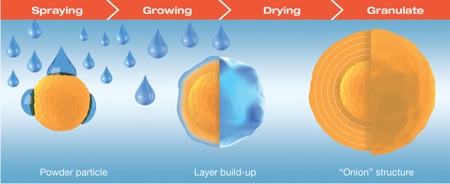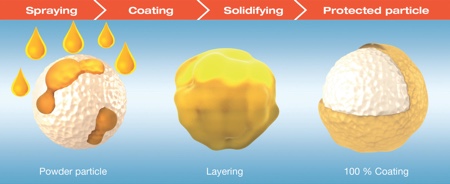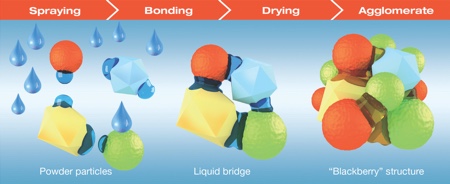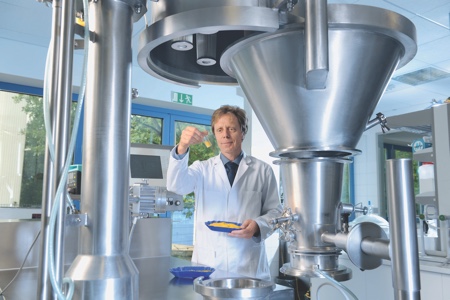Many people have difficulty swallowing tablets and capsules. These dosage forms can sometimes be too large, stick in one’s throat and taste or smell unpleasant. Instantised drinks, direct granulates, effervescent or chewable tablets and coated pellets, for example, can help to increase the user friendliness of the products for the patients. With the aid of fluid bed technology it is possible to produce such dosage forms with tailor-made attributes and in standardised quality.
Fluid bed technology involves drying a product in a processing chamber in a controlled environment. Heated, dehumidified and filtered air is passed into the plant’s material container from below, through a screen. This special bottom screen ensures that the air has specific flow characteristics. The starting substances are mixed homogeneously, and a fluid bed is created in which the particles are practically isolated and their entire surface is exposed to the medium to be added.
Besides the air for drying, water-based liquids, such as suspensions and emulsions, can be injected through nozzles. The particles can then be dried to the desired final moisture content. Since drying can be carried out in a low and therefore gentle temperature range, the products are normally exposed to only moderate heat between 30°C and 50°C, thus minimising any thermal effects. That makes fluid bed technology ideal for processing heat-sensitive ingredients such as enzymes, flavourings and vitamins. Besides gentle drying, the method can also be used for precise and efficient granulation, agglomeration, coating and microencapsulation.
Gentle drying: Fluid bed drying has a number of advantages over conventional spray drying. In this method, it is not only a case of removing the moisture from the product. The aim is to achieve a dry product with precisely defined structures and parameters. For example, it is possible to produce a dustless powder or a free-flowing granulate with a defined particle size that has excellent dispersion properties. The products that emerge from a fluid bed dryer dissolve much better in liquids than the fine powders resulting from spray drying.
One example of an application is the drying of enzymes. The liquid enzyme is sprayed onto a carrier and then subjected to a gentle drying procedure. The finished granulate of the active substance has optimal characteristics for further processing. The method can also be used for applying vitamins to a carrier or adjusting products to extremely low residual moisture levels.
Spray granulation for a homogeneous particle structure: Spray granulation can be used to produce compact, almost round granulates with excellent physical properties. Liquids containing solid matter are atomised and encounter the granulation seeds in the form of droplets. In the process, the liquid evaporates and the solid matter is adsorbed to the granulation seed to form a coating. This takes place repeatedly in the fluid bed, resulting in granulates made up of layers or ‘shells’. Spray granulates are characterised by a high particle density and a low specific surface area; this makes them especially suitable for the subsequent application of functional layers by coating. Spray granulation permits very precise adjustment of parameters such as particle size, residual moisture and bulk volume. The method is used, for example, when the objective is to create a homogeneous, dustless product with a high bulk weight.

Figure 1: Spray granulation
Agglomeration for better tableting properties and solubility: If the aim is to create a free-flowing product with optimum solubility and a low bulk density rather than a compact granulate, the best choice is fluid-bed agglomeration. In the agglomeration process a liquid, best of all water alone, is sprayed into the fluid bed consisting of powder. Wetting of the surface of the particles and simultaneous drying causes the powder particles to adhere to each other and form free-flowing agglomerates. Bridges of solid matter form between the individual particles in the course of drying, thus causing the agglomerates to grow. This improves the physical handling of the goods, since the agglomerates produced in this way contain far less dust, have better tableting properties, are readily soluble and also easier to dose because of their enhanced flowability.
Moreover, agglomeration prevents the individual components from separating again during subsequent processing. With pharmaceutical products, a very high level of homogeneity is essential, for whatever the dosage form – whether tablets or capsules – each dose must contain the same amount of the active ingredient. In the fluid bed processor, even minute amounts of the substances are firmly bound in the agglomerate; this ensures homogeneity and prevents separation.
Coating with functional surfaces or protective films: In the coating process, the individual particles are covered with a layer that gives the product a specific functionality. Liquids containing the coating material to be applied in the form of a solution or suspension are sprayed onto the powder. As in spray granulation, the water evaporates in the individually conditioned drying air. The coating material is deposited densely on the particles, ultimately creating a closed surface. The purpose of this thin, even coating of melted fats, sugar dissolved in water or functional polymer mixtures, for example, is to protect the solid substance against external influences such as light, oxygen or moisture.

Figure 2: Coating
Various coating methods are used for tablets, among other things, to shield sensitive substances against the gastric juices by means of a functional surface and transport them into the intestines. It is possible to build up coatings that dissolve either partially or completely, depending on the pH. In the manufacture of sustained release preparations, special coatings are used to spread the release of active ingredients over a defined period by means of ‘slow release’ or ‘controlled release’ mechanisms. Particles may also be coated to enhance their appearance, prolong their shelf-life or mask an unpleasant taste.
Microencapsulated granulates: Microencapsulation differs from coating in that solid or liquid active substances are bound homogeneously into a carrier. It results in particles with precisely defined attributes that are resistant to external influences. Microencapsulation offers effective protection of enclosed droplets of liquid, such as omega-3 fish oils, against oxidation, thus greatly prolonging the shelf-life of the product.

Figure 3: Agglomeration
Outsourcing production
Fluid bed technology permits a great diversity of applications. But for small- or medium-sized companies and manufacturers with a frequently changing range of products it is a challenge to install expensive plant or constantly replace equipment to ensure it is always state-of-the-art. So it may make sense to outsource production.
SternMaid, one of the leading contract manufacturers of powdered foods and ingredients and also APIs and excipients, has the latest plant and equipment. In 2012, the company invested some €5m in a fluid bed processor; as a result it is optimally set up for the flexible and efficient production of functional ingredients or end products. The company conducts trials on a pilot scale to develop new products or optimise existing ones. Full-scale production then takes place on one of the most modern fluid bed processors currently on the market. The plant is designed for continuous or batch operation, depending on the amount to be produced and the method to be used.

Using the pilot scale facilities
To meet other requirements, SternMaid also has eight different blending lines for powders and three for liquids. The company’s modern container blending line, suitable for blending vitamin compounds, has been certified by the competent pharmaceutical inspectorate according to Part II of the EU GMP Guide. It permits the blending, processing and filling of APIs and excipients according to strict regulations.




